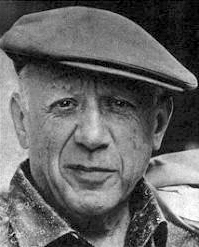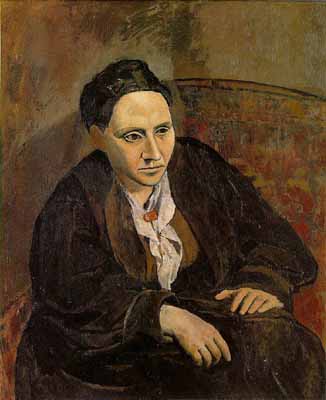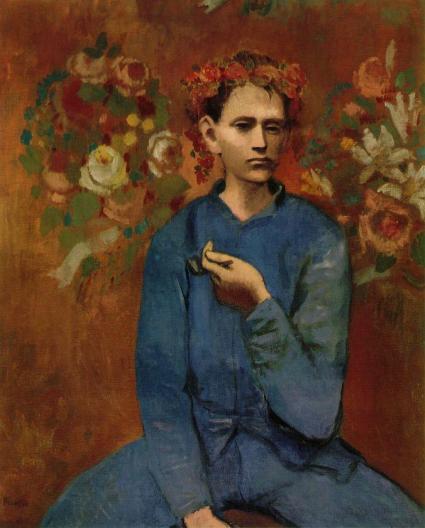| Pablo Picasso | |
|---|---|
 |
|
| Born | Pablo Diego José Francisco de Paula Juan Nepomuceno María de los Remedios Cipriano de la Santísima Trinidad Ruiz y Picasso Oct. 25, 1881 Málaga, Spain |
| Died | Apr. 8, 1973 (aged 91) Mougins, France |
| Nationality | Spanish |
| Education | José Ruiz y Blasco (father); Real Academia de Bellas Artes de San Fernando |
| Movement | Cubism |
| Field | Painting, Drawing, Sculpture, Printmaking, Ceramics |
| Works | View Famous Works Les Demoiselles d’Avignon (1907) Guernica (1937) The Weeping Woman (1937) |
“Painting is just another way to keep a diary.” – Pablo Picasso
Picasso is the foundation of modern art. His movement, Cubism has influenced many artists since it was born. According to Picasso, “Every act of creation is first an act of deconstruction,” which is true for cubism, because it breaks apart the picture only to put it back together again in an abstract way.
Personal Life
Picasso was born into an artist’s family. His dad painted professionally and taught him art from a very young age. He started painting at seven, which was unusual back then. Picasso was born on October 25, 1881, right into the golden age of Impressionism and Realism. His father was a realist, but Picasso hated all formalities in art.
He attended the Royal Academy in San Fernando, Spain, but dropped out after a few days. Formal training allowed no creativity, so instead of going to school, he decided he would just go to all the local art exhibits and look at them for hours on end.
Gertrude Stein, an American art collector, was looking at one of the local galleries where Picasso had some of his art work on display, and was completely amazed by it. She started buying his work and showing it off in her gallery at her house in France. He thanked her by painting a portrait of her, which is the last of his realistic art.
 In 1904, Picasso met Fernande Olivier, who became his mistress. Olivier appears in many paintings during his Rose Period. After acquiring fame, he left her for another woman Marcelle Humbert, whom he nicknamed Eva Gouel. This was the only woman he ever truly loved, and he was devastated when she died in an accident. She appears in many of his cubist works, but is hard to distinguish due to the abstraction of his art.
In 1904, Picasso met Fernande Olivier, who became his mistress. Olivier appears in many paintings during his Rose Period. After acquiring fame, he left her for another woman Marcelle Humbert, whom he nicknamed Eva Gouel. This was the only woman he ever truly loved, and he was devastated when she died in an accident. She appears in many of his cubist works, but is hard to distinguish due to the abstraction of his art.
His first marriage was in the summer of 1918, to a ballerina Olga Khoklova. She danced with the Sergei Diaghilev Troupe, and they met because Picasso was designing a ballet for Troupe. They had one child, a boy named Paulo, and he grew up to be a chauffeur for Picasso. They separated soon after because Picasso didn’t want to get a divorce, or he would have to have given Olga 50% of all his wealth.
 In 1927, he met 17 year old Maria-Thereus Walter, and began having an affair with her. They had a daughter, Maia, but they never married, despite her wishes. Four years after Picasso died, she hung herself.
In 1927, he met 17 year old Maria-Thereus Walter, and began having an affair with her. They had a daughter, Maia, but they never married, despite her wishes. Four years after Picasso died, she hung herself.
Works
Picasso’s work falls into several categories depending on his life and the world around him. His beginning work was semi-realistic like his father, but over time he began to pursue other aspects in painting.
The Blue Period (1901-1904) is characterized by all the canvas being some shade of blue. This was a dark time in his life. His best friend had committed suicide, and he was depressed by this. Paintings like The Old Guitarist (1903) reflect this mood. The man in this painting is gaunt, withered away and hunched over his guitar. The painting makes the viewer feel the melancholy that the man is feeling.
After the Blue Period came the Rose Period (1904-1906). Most of his paintings during this time have roses in them, or are pink like roses. Fernande Olivier is painted in many of these paintings, for he used her as his model. All of these paintings are upbeat in comparison to the Blue Period, and they are meant to reflect the French culture he was being exposed to.
 From 1907-1909, he became highly interested in African art, and produced one of his most famous pieces during this time, Les Demoiselles d’Avignon. The women’s faces, in this work, look like masks and the bodies are all angular. This marked the official beginnings of Cubism.
From 1907-1909, he became highly interested in African art, and produced one of his most famous pieces during this time, Les Demoiselles d’Avignon. The women’s faces, in this work, look like masks and the bodies are all angular. This marked the official beginnings of Cubism.
Cubism officially began in 1909, when Picasso began collaborating with another artist George Braque. George is actually accredited with the creation of Cubism, but Picasso made it popular.
Many of his paintings after this are Cubism, but then Cubism is divided up into two sections. At this time, he also started doing other art projects like sculpture and house hold items. A majority of his work became anti-war pieces. Take Guernica, for instance. Guernica was painted in 1937, as a protest to the Spanish Civil War, and the atrocities happening in it. Guernica is a small town in Spain that was subjected to a massive bombing spree by the rising dictator at the time. Most of the inhabitants were killed, and the world didn’t even know about it until this painting was shown at the World Fair in Paris in 1938. This painting depicts the horrors of war, with the dead people on the ground, people running for their lives, mom’s holding their dead children in their arms; this painting depicted the tragedies that took place at Guernica.
For all his anti-war pieces though, Picasso was a communist. He went to several meetings in his town and took place in peaceful gatherings of his fellow communists. This is ironic, because the Nationalist party in Spain at the time was the one who bombed Guernica.
Picasso in all produced over 50,000 pieces of artwork during his lifetime. He died on April 8, 1973 in France while having dinner with his friends. His second wife, Jacqueline, took her own life in 1986 because she was so lonely without him.